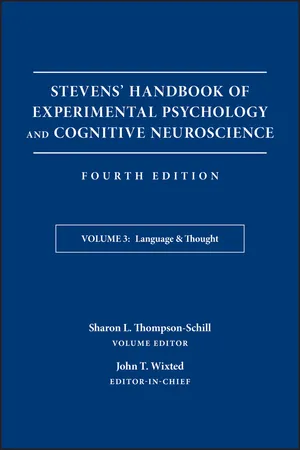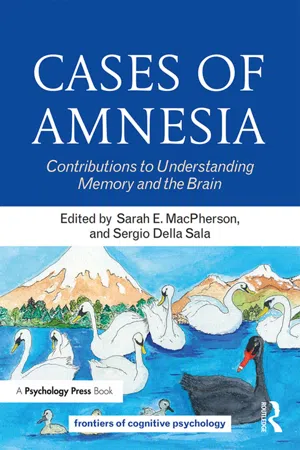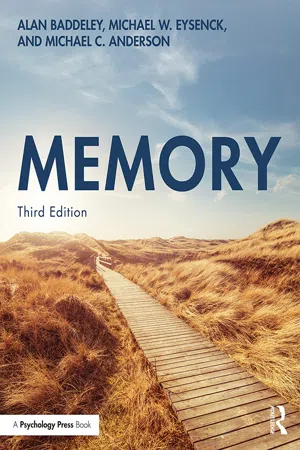Psychology
Semantic Knowledge in Patient HM
Semantic knowledge in patient HM refers to the ability to understand and use language to convey meaning. HM, a patient with severe amnesia, retained his semantic knowledge despite his inability to form new memories. This suggests that semantic memory is distinct from episodic memory and is stored in a different part of the brain.
Written by Perlego with AI-assistance
Related key terms
Related key terms
1 of 4
Related key terms
1 of 3
6 Key excerpts on "Semantic Knowledge in Patient HM"
- eBook - ePub
- (Author)
- 2018(Publication Date)
- Wiley(Publisher)
Evidence from individuals with severe episodic memory deficits can help address the question of whether a functioning episodic memory system is necessary to acquire new semantic knowledge. For instance, research on the famous amnesic patient H. M. revealed that after the surgery that led to his amnesia, he acquired some new semantic knowledge (e.g., for words that came into common use after his surgery cf. Gabrieli, Cohen, & Corkin, 1988 and O'Kane et al., 2004). Two other individuals who became amnesic as adults have also exhibited some, albeit extremely limited, new semantic knowledge after the illnesses that led to their amnesia (Bayley, O'Reilly, Curran, & Squire, 2008; Bayley & Squire, 2005). Furthermore, individuals who have had amnesia since early childhood appear to have relatively intact semantic knowledge, despite the fact that they had little time to acquire semantic knowledge when their episodic system was intact (Bindschaedler, Peter-Favre, Maeder, Hirsbrunner, & Clarke, 2011; Gardiner, Brandt, Baddeley, Vargha-Khadem, & Mishkin, 2008; Vargha-Khadem et al., 1997). Although such evidence seems to suggest that semantic knowledge can be acquired without an intact episodic memory system, it is worth noting that semantic knowledge acquisition in these amnesic patients is not normal (e.g., it is acquired very slowly and laboriously). It is therefore possible that these patients may possess sufficient remaining episodic memory to allow for the acquisition of semantic knowledge (Squire & Zola, 1998). Another (compatible) possibility is that the acquisition of semantic memory normally makes use of the episodic system, but that other (less efficient) points of entry can be more heavily relied upon when the episodic system is damaged (or has not yet developed fully).What might be some of these points of entry? As one might imagine given the prominence of sensorimotor-based models, sensory and motor information that may be acquired implicitly is an obvious candidate. And in fact, there is clear evidence from studies on the development of conceptual knowledge in young children that sensory and motor information are important for developing semantic knowledge about object concepts. Some of this evidence comes from studies examining how young children categorize and make inferences about novel objects. In one study, for example, when 2-year-old children were presented with a novel object and instructed to move it horizontally, they were more likely to consider it to be similar to (i.e., to categorize it with) another novel object whose long axis extended horizontally than to one whose long axis extended vertically, whereas the preference was reversed for children who moved the original novel object vertically (L. B. Smith, 2005). Thus, motor information had an implicit influence on their categorization, which presumably affects their conceptual representations. - eBook - ePub
Cases of Amnesia
Contributions to Understanding Memory and the Brain
- Sarah E. MacPherson, Sergio Della Sala, Sarah E. MacPherson, Sergio Della Sala(Authors)
- 2019(Publication Date)
- Routledge(Publisher)
a priori, that patients with a degraded semantic system would retain knowledge of core characteristics and canonical function (e.g., a jug holds liquid, enables pouring) better than less common functions (e.g., a jug can be used as a vase). KE and WM’s idiosyncratic knowledge highlights the importance of direct personal experience as distinct from frequency of encounter or generic markers of familiarity.Another finding that was unique at the time related to the disproportionate effect of current experience and the documentation in these patients of an inverse temporal gradient of retrograde memory. The findings, which have subsequently been demonstrated by others (Hodges & Graham, 1998), forced us to re-evaluate the nature of semantic memory and its relationship with autobiographical and episodic memory.Can you specify why these cases were relevant in relation to the knowledge at the time and would they still be relevant to the knowledge of today?
They were relevant for a number of reasons. On the one hand, the patients’ severe yet relatively circumscribed disorder of semantic memory provided a validation of the theoretical distinction between semantic and episodic memory, which had been advanced two decades earlier (Tulving, 1972, 1983). On the other hand, these cases provided challenges to existing accounts of semantic memory. In Tulving’s original formulation, semantic memory was defined as information that is i) acquired early in life, ii) culturally shared and iii) not tied to a particular temporal or spatial context. The implication was that semantic knowledge of words and objects, once acquired, represents an essentially stable knowledge base that is independent of autobiographical experience. Language-based models of semantic memory, construed in terms of a hierarchical network (Collins & Quillian, 1969) or a set of defining and characteristic features (Smith, Shoben & Ripps, 1974), also supposed a relatively static storehouse of concepts, divorced from experience. Yet, the findings in KE and WM suggested a more complex and dynamic interplay between semantic memory and personal experience. - eBook - ePub
- Alan Baddeley, Michael W. Eysenck, Michael C. Anderson(Authors)
- 2020(Publication Date)
- Routledge(Publisher)
7SEMANTIC MEMORY AND STORED KNOWLEDGE
Michael W. Eysenck
Introduction
What is the capital of France? How many months are there in a year? Who is the current President of the United States? Do rats have wings? What is the chemical formula for water? Is umplitude an English word? What do seismologists do? Is New York south of Washington, D.C.? What is the typical sequence of events when having a meal in a restaurant?I am sure you found all the above questions relatively (or very!) easy to answer and that you answered them rapidly. We could easily fill the whole of this book with such questions—we all possess an enormous store of general knowledge that we take for granted. All this information is stored in semantic memory. Binder and Desai (2011, p. 527) provided a detailed definition of semantic memory: “It is an individual’s store of knowledge about the world. The content of semantic memory is abstracted from actual experience and is therefore said to be conceptual, that is, generalized and without reference to any specific experience.”If you stopped the first woman you saw and tested her vocabulary, you would probably discover she knew the meaning of between 20,000 and 100,000 words. She might also know a foreign language. She would certainly know a great deal (in geographical terms) about her own neighborhood and about the wider world. She functions well in her environment because she has learned to drive a car, use a cell or mobile phone, use credit cards, and so on.She also has a great deal of specialist knowledge acquired in connection with work, hobbies, and pastimes. In addition, she has the usual interesting but nonvital mental baggage (much of it media-related) that most of us carry around in our heads—facts and images to do with politics and sport, movies and music, TV programs and celebrities.There is much overlap in the knowledge each of us has stored in semantic memory (e.g., basic vocabulary; general knowledge of the world). However, there are also large individual differences. For example, we have much more information than most people stored in semantic memory in those areas of special interest and importance to us (e.g., work-related knowledge). Consider expert chess players. Chassy and Gobet (2011) analyzed over 70,000 games played by chess players of varying skill levels. They estimated chess masters have memorized 100,000 opening moves! Overall, there was a very strong relationship between chess-playing skill and knowledge of opening moves. - eBook - ePub
The Psychology of Cognition
An Introduction to Cognitive Neuroscience
- Durk Talsma(Author)
- 2023(Publication Date)
- Routledge(Publisher)
Episodic memory is constructive. That is, memories are reconstructed from the individual memory traces when they are retrieved. The functions involved in this reconstruction can also be used for imagining future scenarios. In addition, these reconstructive processes result in people becoming sensitive to false memories. This sensitivity appears to increase with age. The hippocampus in particular appears to be involved in these reconstructive processes.Semantic memory is formed by a network of interconnected concepts, where the activation of specific concepts results in the activation of related concepts through the principles of spreading activation. Originally, concepts were assumed to be organised in a hierarchical way. Although the original models aiming to describe this hierarchy generated predictions that were inconsistent with the empirical evidence, later results indicate that there is indeed a hierarchical organisation of concepts. Here, a basic level, a subordinate level, and a superordinate level can be distinguished. Although most concepts are named at the subordinate level, this is not always the case, for example in the case of experts, who often describe objects in the domain of their expertise at the subordinate level.Initially, it was believed that concepts were represented in semantic memory in an abstract and amodal manner. This idea has been surpassed by an increasing number of studies that have shown that perceptual and motor codes are also represented in semantic memory. For this reason, it is currently more common to think of semantic memory in terms of a hub-and-spoke model.A final organisational principle that we can identify in semantic memory consists of schemas and scripts. These knowledge structures represent the underlying organisation of concepts. Scripts describe a sequence of actions. Neuropsychological studies indicate a double dissociation between patients who have a deficiency in the representation of semantic concepts and patients who have a deficiency in the sequencing of actions. Scripts often consist of clusters of action patterns.Non-declarative memory is traditionally characterised by all processes that are not accessible to consciousness. These include habituation and sensitisation, priming, classical conditioning, and procedural learning. This distinction was initially identified on the basis of studies with amnesia patients. However, more recent neuroimaging studies imply that the classical distinction is no longer tenable. There does not appear to be a strict separation between implicit and explicit memory, and the involvement of the underlying neural mechanisms also depends on specific task conditions. - eBook - ePub
- Ekrem Dere, Alexander Easton, Lynn Nadel, Joseph P Huston(Authors)
- 2008(Publication Date)
- Elsevier Science(Publisher)
Much of the evidence on both sides of this debate comes from patients with MTL damage. Squire and others (Squire and Zola, 1998 ; Lou and Niki, 2002 ; Manns et al., 2003 ; Squire et al., 2004) emphasize that at least some amnesics appear to have significant deficits in semantic memory retrieval, even for well-established world knowledge. However, semantic memory impairment tends to be extensive only when the damage extends beyond the hippocampus to other MTL and neocortical structures (Schmolck et al., 2002) and can reach the same level of deficit as autobiographical memory loss, or even exceed it, in some patients (Bayley et al., 2003 ; Bayley and Squire, 2005). Alternatively, a recent review of the patient literature (Moscovitch et al., 2006) concluded that retrograde amnesia for semantic memory is either spared completely or confined to a period of about 10 years prior to the head injury, providing that the damage is limited primarily to the hippocampal formation. While the extent of hippocampal involvement in retrieval remains controversial, there is little doubt that acquisition of new episodic and semantic memories is impaired by damage to the hippocampus, at least when the injury is acquired in adulthood. Anterograde amnesia remains a defining feature of the amnesic disorder (Milner, 2005 ; Keane and Verfaellie, 2006). Cases of developmental amnesia caused by hippocampal damage early in life are interesting because of the remarkable amount of semantic information that these individuals acquire despite profound deficits in episodic memory (de Haan et al., 2006), although their acquisition of new knowledge is not completely normal (Vicari et al., 2007). Adult-onset amnesics too can learn new semantic information, but it is clearly a very inefficient learning process and the resulting knowledge is inflexible and does not easily generalize to other contexts (Baddeley and Wilson, 1986 ; Glisky et al., 1986 ; Wilson and Baddeley, 1988) - eBook - ePub
- Gregory Hickok, Steven L. Small(Authors)
- 2015(Publication Date)
- Academic Press(Publisher)
Section K Conceptual Semantic Knowledge OutlineChapter 61 The Hub-and-Spoke Hypothesis of Semantic Memory Chapter 62 What Does It Mean? A Review of the Neuroscientific Evidence for Embodied Lexical SemanticsPassage contains an image
Chapter 61The Hub-and-Spoke Hypothesis of Semantic Memory
Karalyn Patterson1 , 2 and Matthew A. Lambon Ralph3 ,1 Neurology Unit, Department of Clinical Neurosciences, University of Cambridge, Cambridge, UK,2 MRC Cognition and Brain Sciences Unit, Cambridge, UK,3 Neuroscience and Aphasia Research Unit, School of Psychological Sciences, University of Manchester, Manchester, UKSemantic memory represents our knowledge about the meanings of words, objects, people, and all other verbal and nonverbal stimuli that we encounter in the world. The semantic network in the human brain encodes all of this information, reactivates it rapidly and effortlessly, and generalizes appropriately across different exemplars and situations to form coherent concepts. This chapter considers how coherent concepts are formed and argues that the semantic network must include both modality-specific primary and association areas and a crucial transmodal hub. Drawing on evidence from normal and disrupted semantic processing, we consider the growing evidence that regions in the anterior temporal lobe (ATL) are the foundation of this representational hub and assess the possible roles of left versus right and dorsal to ventral ATL subregions.Keywords
Anterior temporal lobe; semantic dementia; hemispheric differences; embodied cognition; transcranial magnetic stimulation61.1 Introduction
The quantity of, quality of, and speed of access to semantic knowledge in the human brain is astonishing. Given any fragment of information, such as the word “camel,” a healthy adult human can almost instantly generate a vast amount of other related information, such as the ways in which camels are and are not like other animals, how they look and move, where they live, how they interact with people, that it is the name of an American brand of cigarettes, that they are the subject of a famous story by Rudyard Kipling (How the Camel Got His Hump ), and so forth. Curiously, this kind of conceptual knowledge—although often discussed by philosophers—did not become a major topic of research in cognitive science and neuroscience until relatively recently. Endel Tulving put it on the psychological map in 1972
Index pages curate the most relevant extracts from our library of academic textbooks. They’ve been created using an in-house natural language model (NLM), each adding context and meaning to key research topics.
Explore more topic indexes
Explore more topic indexes
1 of 6
Explore more topic indexes
1 of 4





